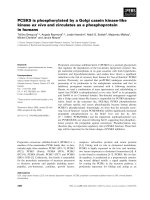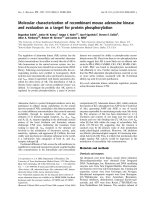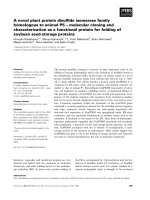Access to Finance and Markets as a Strategy to Address Poverty
Bạn đang xem bản rút gọn của tài liệu. Xem và tải ngay bản đầy đủ của tài liệu tại đây (180.93 KB, 4 trang )
SPECIAL REPORT
Access to Finance and Markets
as a Strategy to Address Poverty
BY NACHIKET MOR
AND BINDU ANANTH
Introduction
belief in our work on creating access to financial services is that almost all regions of
India possess a set of economically viable occupations (such as
buffalo rearing, running a rural provision store, fruit and vegetable vending and engaging in simple home based craft) that
even the very poor can almost immediately engage in without
the need for any specialized inputs or skill building. Since
these occupations essentially rely on public goods (such as
A K E Y A N D A L M O S T AX I O M AT I C
An Indian bank employee counts rupee currency notes.
44
Development Outreach
WORLD BANK INSTITUTE
public grazing lands) to provide raw materials and “in-home
under-employment” to provide labor, at the margin they have
very high rates of return—well in excess of 100 percent per
annum (Helms and Reille 2004).
An important guiding principle is that the only input
required to leverage these sets of economic opportunities is
access to basic financial services, which include savings, credit,
insurance and tools for risk management. This is in contrast to
the view that access to financial services can impact poverty
alleviation only if accompanied with other complementary
inputs, typically training and skill development interventions.
For example, micro-loans (typically amounts less than USD 250
per household), in a region as poor as the Mirzapur District of
Uttar Pradesh, can allow families, too poor to afford even two
meals a day, to start with extremely low-skilled occupations
such as buffalo rearing and gradually reach a level where they
can afford minimal meals and withdraw their children from the
work-force for attending school.1 Even where the micro-loans
are not used to finance new income generating activities but to
refinance higher cost debt, this immediately releases new
resources for the household to finance existing consumption or
incremental production activities. Micro loans also provide an
important source of liquidity to meet fixed commitments (such
as school fees) despite income flows being extremely seasonal.
The pathway to universal financial
services access
the premise of the centrality of “access to
finance” in providing a pathway out of poverty for several
households, then the first challenge to be addressed would be
how such access may be universalized with every individual
being able to avail a basic set of financial services.2 To provide
this access, the following steps appear necessary (Mor 2006):
I F O N E AC C E P T S
1
Development of a network of community based financial
institutions, which have the ability to provide these financial
services. This network of institutions could include
Cooperative Banks, Non-Banking Financial Companies
(NBFCs), local bank branches of commercial banks, Civil
Society Organizations or Producer Cooperatives, as the case
may be. The requirement is that these institutions are able to
develop operating models that draw on local information and
operationalize sufficiently low cost structures that make the
business of serving the poor sustainable over the medium
term. Within India, the belief is that a network of over 200
such entities, each with the capability to serve a million
households, would be needed (Ananth et al 2004).
2 The participation of one or more main-stream financial
institutions that are willing to partner with these entities to
provide:
Financial resources for on-lending: ICICI Bank’s
Partnership Model is an example of a financing model that
uniquely leverages the local presence of these entities with
the ability of the bank to diversify risk and provide wholesale lending funds in large quantum.3
Access to equity capital for growth.
Financial
engineering:
securitization
( />id=2413549) and product development, health insurance,
rainfall insurance (Hess 2003 and Sinha 2004), savings,
risk management.
Direct links with capital markets as the entities mature
(www.gfusa.org/programs/india_initiative/grameen_
capital_india/).
3 Creation of an enabling environment that can support the
continued growth in the number of entities that make up this
network in India. The following steps have thus far been taken
in India in this pursuit:
■
■
■
■
Creation of Venture Capital Funds engaged in the task of
identifying and providing equity finance, and mentoring
new entrepreneurs desirous of creating such entities.4 This
combined with Takeout Finance where a bank is prepared to
automatically partner with a successfully created entity and
permit it to repurchase the equity invested by the Venture
Capitalist (VC) at a pre-agreed minimum rate of return to
the VC. Once the process of creation is successfully completed, mezzanine equity of the type provided by ICICI
Bank’s Partnership Model referred to earlier is a cheaper
and a more appropriate source of equity for successful entities relative to equity capital being provided by VCs.
Creation of specialized institutions such as the Centre for
Micro Finance (CMF) at IFMR (www.ifmr.ac.in/cmf) and
the Centre for Insurance and Risk Management (CIRM)
IFMR (www.ifmr.ac.in/cirm) and the Centre for Innovative
Financial Design at IFMR (www.ifmr.ac.in/cifd) to provide
research and product design capabilities both at a basic
level and at an advanced level.
Launch of FINO, an Application Services Provider (ASP)
that seeks to provide front-end (smart card, point-of-sale
terminals), back-end (banking software, performance
management and reporting, MIS) and information services (credit bureau) to these institutions (www.fino.co.in).
This architecture of technology ASPs enables micro-banking operations to enjoy the same transaction quality and
cost as is the case with a large bank.
Launch of MicroFinanceJobs.com to provide access to
human resources to these entities so that their expansion is
unconstrained (www.microfinancejobs.com).
Regulation that permits the use of business correspondents for extending access to basic banking operations.
It is expected that with these three broad strategies it should
be possible to scale the access to finance quite rapidly. In the
case of ICICI Bank in India; operating with this three pronged
approach, it has catalyzed the creation of over 100 micro
finance partners and in three years has been able to go from
USD 1.2 million in micro-loans extended to about 20,000
clients to over USD 522 million being provided to about 3 million clients in a three-year period (www.icicibank.com and
Anand 2006).
■
■
■
■
■
Addressing other missing markets
F I N A N C I A L S E RV I C E S for the poor have long been considered
a “missing market” owing to the information constraints that
characterize it. Once the “access to finance” challenge has been
overcome through the mechanism described in the previous
section (and even while it is in the process of being overcome),
the belief is that most of these households would be able to
come up to a minimum level of subsistence. A basic premise of
the first phase of work described earlier, is to let individuals
choose a set of activities based on their capabilities and the
context in which they operate and focus exclusively on the
rapid universalization of the provision of financial services.
However, it is very likely that such households would continue
to be poor and therefore vulnerable to even moderate levels of
J U N E
2 0 0 8
45
systemic shocks to their economic environment (Khanna
2006). This is when “missing markets” in other services for
the poor start to become important. These may be in several
areas including skill building, quality control and productivity
improvement.
In our view taking clients to the next level of economic
activity needs a much more concerted effort and one that
builds on the fact that a large population of economically
active poor now have access to basic financial services and
have “revealed” their preference for certain activities. The
challenge is to build effective linkages to mainstream markets. For example a majority of microfinance clients are
engaged in dairying. Given this, any intervention in dairy productivity enhancement, while being consistent with a bank’s
business objectives, also provides access to such services to
those clients that have already indicated their willingness to
undertake this activity. Along the same lines, it may now be
possible to think of other interventions that, while not being
distortionary, improve value realization within the occupations that individuals are already engaged in. The fact that
clients are willing to pay for these value-added-services by
taking loans provides a powerful signaling device to providers.
Traditional models of technical assistance and livelihood
development are unable to resolve whether the phenomenon
of clients not paying for the services delivered is due to affordability constraints or lack of perceived value.
Towards this goal of addressing missing markets for livelihood services to clients, one promising strategy appears to be
to complement the existing work of MFIs in financial services
access with supply chain strengthening for various activities
that the same client group is engaged in. One such architecture is being innovated by the IFMR Trust’s Network
Enterprises Fund (www.ifmrtrust.co.ins).
IFMR Trust is creating a series of specialized “Network
Enterprises” (NEs), which will be able to improve producer
realization within specific value chains. Network Enterprises
will be prioritized in areas that can add targeted services to the
livelihood that clients are already engaged in. Each of these
NEs will address specific supply chain problems and ensure
adequate supply of finance by making available to banks
opportunities for structured debt.
There are other opportunities for MFIs to positively impact
client livelihoods. A couple of these are detailed below:
1
Developing carefully structured partnerships between
grass-roots organizations and large companies so that at
terms of trade that are fair, inputs such as commodity marketing and hedging services, cattle feed supply and fruit and vegetable procurement services can be provided to the clients of
these grass-roots organizations.5 Once again, the belief is that
clients will be willing to pay for these services if the links to
price realization are directly apparent. The scalability of
micro-enterprises of micro finance clients is often limited by
credit constraints faced by the individuals/enterprises higher
in the value chain. Business models to provide finance to
Small and Medium Enterprises on a very large scale might
serve to increase the market potential of the entire chain.6
46
Development Outreach
WORLD BANK INSTITUTE
2
Working closely with micro-finance institutions (MFIs)
and other grass-roots organizations on health and productivity interventions that are paid for directly or indirectly by the
MFI’s client. Examples of interventions in this category
include distribution of smokeless cooking ovens, treated bed
nets and iron pills to cure anemia. While these have been
viewed as important interventions for several years, the
mechanism of distribution through MFIs has the advantage of
being able to meet financing requirements to pay for these
interventions as well as leverage the high frequency of client
contact that MFIs enjoy.
The belief in all these cases is that in order to provide these
“goods and services” at a scaled level and to actually deliver
value to both ends of the supply chain, highly competitive and
large entities would be required which would seek to link
small rural producers and service providers with some of the
largest markets in the world. MFIs represent an important
customer aggregation channel but may not be effective as a
multiple services provider.
Conclusion
I N T H E P R E C E D I N G PA R AG R A P H S it has been argued that
there exist a set of market-based approaches that have the
potential to address poverty on a scaled basis. At the heart of
this approach is building universal access to financial services as a starting point. It is suggested that such access is best
provided in a commercial and sustainable manner through
creative partnerships between banks and a network of local
financial institutions. The information gained from observing
the unconstrained livelihood choices of clients, the scale of
financial access created and the implementation capability of
local financial institutions then provide the unique opportunity to conceptualize well targeted livelihood enhancement
interventions for this population. The belief is that interventions that build systematically on an “access to finance” component and subsequently include an “access to markets” component have the potential to provide large positive income
shocks. The appeal of this approach is that it is fundamentally
rooted in a commercial proposition both for the participating
client as well as for the service providers. Therefore, the
promise of scalability is higher than in traditional grant-led
livelihood development programs.
Nachiket Mor is President of the ICICI Foundation, India; a member
of the Board of Governors of the Institute for Financial Management
and Research (IFMR), Chennai, India, and the Chairman of its
Managing Committee; and a member of the Board of Directors of
CARE USA ().
Bindu Ananth is President of the IFMR Trust
().
A more comprehensive version of the article with a complete list of
references is available at WBI’s Business, Competitiveness and
Development website: www.devandbiz.org.
A c c e s s t o F i na n c e
continued on page 51
Bridging Gaps
A c c e s s t o F i na n c e
continued from page 40
continued from page 46
Lessons learned
O N E K E Y L E S S O N from this project shows that health and non
health-related organizations and individuals can be motivated to participate in health-related social responsibility activities. In presenting an effective proposal to a prospective SR
partner, it is essential for the partner to understand that the
partnership is mutually advantageous.
The impact of Takamol’s SR activities has been enhanced by
its relevance to the various components of the Takamol integrated model, which provides a mutually-reinforcing structure
for SR at the community, governorate, and national level.
Stakeholder benefits
has mediated a range of successful
health partnerships in Egypt. In these partnerships, each
stakeholder reaps benefits. For example, in the case of
Barclays Bank Egypt, the people of the urban poor area have
benefited from a clean, well equipped clinic that provides
quality care.
Meanwhile, Barclays has benefited through its exposure to
new potential clients, through contributions that have been
efficiently and effectively used and had measurable impact. In
addition it has an enhanced reputation as a socially responsible business.
T H E TA K A M O L P R O J E C T
Everybody wins!
for all parties when social responsibility programs are implemented is enormous. The Takamol
project has successfully started a trend that an increasing
number of businesses and individuals are now following. At a
recent CSR conference in Cairo, Barclays Bank Egypt’s
Finance Director made it very clear why his organization
became involved in CSR with the Takamol project; and why
others should also. In summarizing he simply stated, “because
everybody wins!”
T H E VA L U E C R E AT E D
Andy Cole is Reporting and Documentation Specialist of Takamol
Project.
Mohamed Afifi is Monitoring, Evaluation and Reporting Team Leader
of Takamol Project.
Reem Salah is Corporate Social Responsibility Specialist of Takamol
Project.
The views expressed in this article are entirely personal and should
not be attributed to any of the Institutions with which the authors are
associated. A version of this article was presented for the first time
at the NGO Global Executive Forum at Talloires, France on May 29,
2006.
The support provided by Annie Duflo and Russel Stevenage of IFMR
and Diviya Wahi, Shilpa Deshpande, and Anant Natu from ICICI Bank
is gratefully acknowledged.
References
Ananth, Bindu, Bastavee Barooah, Rupalee Ruchismita and Aparna
Bhatnagar. 2004. “A Blueprint for the Delivery of Comprehensive Financial
Services to the Poor in India,” Working Paper (Chennai, India: Centre for
Micro Finance Research, Institute for Financial Management and Research).
Available via the Internet: />Helms, Brigit and Xavier Reille. 2004. “Interest Rates Ceilings and Micro
Finance: the Story so Far.” Occasional Paper Number 9, CGAP, September
2004.
Khanna, Tarun. 2006. “At home, it’s not just profits that matter.”
International Herald Tribune, February 21. Available via the Internet:
www.iht.com/articles/2006/02/21/opinion/edkhanna.php.
Mor, Nachiket. 2006. “Financial Inclusion Experiences from India.” Speech
given at IDB Annual Meeting at Belo Horizonte, Minas Gerais, Brazil,
March 31. Available via the Internet: (www.ifmr.ac.in/cmf/FIEInmor.pdf).
Endnotes
1 In 1996 Cashpor Financial and Technical Services began providing microcredit in the Mirzapur District of Uttar Pradesh. For more details refer to
www.fao.org/DOCREP/004/AC154E/AC154E03.htm.
2 Centre for Micro Finance at IFMR in Chennai, India (www.ifmr.ac.in/cmf)
is engaged in the task of researching this carefully. Data on the Indian micro
finance market are hard to come by. One estimate puts the demand for these
basic micro-loans with an average size of no more than USD 200 per loan at
over USD 20 billion annually in India with close to 100 million households
without access to these loans.
3 See Ananth (2005), Harper et al (2006) and Reserve Bank of India,
Report of the Internal Group to Examine Issues Relating to Rural Credit
(2005).
4 ICICI Bank has recently tied up with three venture capital funds to extend
seed capital to start-up microfinance institutions. These three funds
include,Bellwether Microfinance Fund (www.bellwetherfund.com), AvishkarGoodwell Fund (www.aavishkaar.org), and Lok Capital fund
(www.lokcapital.com).
5 One such example is the partnership between ICICI Bank and Spandana,
wherein, with the help of the Bank, Spandana negotiated with different cattle-feed companies for improving the yield of buffaloes and therefore the
income of poor households. For more details refer
/>6 IFMR has set up the Small Enterprise Finance Centre (SEFC)
(www.ifmr.ac.in/sefc) to overcome the limited and untimely access to finance
for SMEs.
J U N E
2 0 0 8
51









